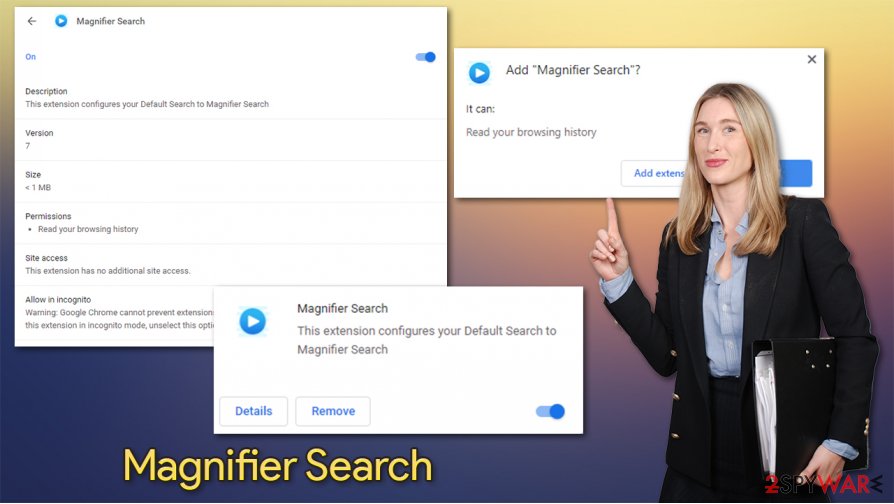Magnifier Search (Removal Guide) - Free Instructions
Magnifier Search Removal Guide
What is Magnifier Search?
Magnifier Search is a browser-hijacking app that will track your browsing history and more

Magnifier Search is a misleading extension that can be found on Chrome Web Store or downloaded along with other software from third-party websites. Once installed, the app changes the web browser settings immediately, although almost no visual changes would be applied to Google Chrome, Mozilla Firefox, Safari, MS Edge, or another web browser. However, as soon as users enter a search query, they would be redirected to Bing, Google, Yahoo, or another search provider. Additionally, the results would be filled with sponsored links and ads.
In the background, the Magnifier Search virus would spy on users' web browsing activities and most probably share that information with unknown parties and partners. This is typical browser hijacker behavior – they promise a lot while providing minimal or no functionality for the end-users, meanwhile hijacking their searches, feeding them with ads, and collecting pay-per-click[1] revenue.
| Name | Magnifier Search |
|---|---|
| Type | Browser hijacker, potentially unwanted program |
| Distribution | Software bundle packages, deceptive ads, fake update prompts |
| Symptoms |
|
| Risks | Installation of other potentially unwanted programs or malware, personals information disclosure to unknown parties, monetary losses |
| Removal | You can uninstall potentially unwanted programs by following the manual guide below or by scanning the computer with powerful anti-malware |
| Optional steps | Computer infections can cause significant damage to system files or disrupt normal settings. To revert these changes and remediate the OS, perform a full system scan with FortectIntego repair software |
As mentioned above, the Magnifier Search extension is misleading. Looking at its description and the pictures of it on the Chrome Web Store, it seems like the hijacker has a purpose and enriched functionality. Here's what the description claims:
Copy and paste our emoticons into emails (like Gmail, AOL MAIL, Outlook Live, Yahoo MAIL!) blogs (like Tumblr, WordPress, and Blogger), or any composer that supports rich text editing.
Additionally, the screenshot for the extension shows that the app is capable of blocking ads, upgrade HTTP connections, and save time by improving internet connection speed. That seems to be like a lot of benefits for just one simple app! However, the truth is that Magnifier Search possesses none of the above-mentioned qualities.
First of all, it is important to note that many users might install the app along with freeware they download from a third-party website. This distribution technique is called software bundling and is often used by potentially unwanted program developers.
As a result, many might not even know that the extension is installed on their web browsers – especially that no significant visual changes to the homepage or the new tab are made. Hence, Magnifier Search removal might not be performed by the infected users for awhile.
Instead of providing the promised functionality, the app is attempting to be sneaking and not expose its presence. Nonetheless, some searches might lead users to other search providers, and another significant change is that the search results would often be filled with sponsored links, leading to unknown websites. Magnifier Search virus developers receive financial gain each time such links are clicked.

If you think that a lack of beneficial functions is not the reason to remove Magnifier Search, you should consider the fact that all your browsing history is tracked as long as you have the app installed on your web browser. Therefore, each visited website is monitored and is most probably shared with other unknown parties. As a result, the presence of the extension might cause privacy issues.
In order to get rid of the Magnifier Search hijack, you need to locate and eliminate the extension that is clipped to your web browser – we explain how below. Keep in mind that if you found this app on your system unexpectedly, it might be that there are other PUPs or even malware present as well. Therefore, security experts[2] recommend scanning the device with powerful anti-malware (such as SpyHunter 5Combo Cleaner or Malwarebytes) and then perform further checks with FortectIntego for best results.
It is easy to avoid browser hijackers
Many users might consider browser hijackers as just a nuisance. In fact, it is partially true – these programs have little to no functionality and attempt to gain revenue by feeding users with ads and tracking their non-personally identifiable information. However, some hijackers can be more persistent and more dangerous, as they can simply compromise the security of the web browser by delivering dangerous links or prevent the removal with the help of built-in features. No matter which way you look at it, there is no reason for you to have such a potentially unwanted program installed on your device.
Therefore, you should be aware of the two main methods of how such apps spread:
- Software bundles
- Fake updates/deceptive ads
You should never rush the installation process of new applications – don't just press “Next” until it is done. Instead, read each of the installation steps carefully and decline all the offers on the way, read the fine print, watch out for pre-ticked checkboxes and always opt for Advanced/Custom settings if prompted.
It is also important to note that patching your software with the latest updates is important, although they should never be downloaded from download prompts (especially for Flash Player)[3] that pop-up on a random web page – these are fake updates and might result in malware infection.

Uninstall Magnifier Search from your browser
It should not be difficult to remove Magnifier Search from your web browser. All you have to do is access the settings section, find the app, and then get rid of it. If you are not sure how to do that, you can check the detailed step-by-step guide we provide below. We also provide instructions on how to eliminate programs manually on both Mac and Windows operating systems – as long as you want to look for PUPs manually.
After Magnifier Search removal, we highly recommend you check your system with powerful anti-malware software to ensure that no malicious programs are present on it. Keep in mind that the most dangerous malware is usually programmed to be invisible and work in the background, without giving away any signs or symptoms. Besides, robust anti-virus would also protect you from potentially unwanted apps and malware in the future.
You may remove virus damage with a help of FortectIntego. SpyHunter 5Combo Cleaner and Malwarebytes are recommended to detect potentially unwanted programs and viruses with all their files and registry entries that are related to them.
Getting rid of Magnifier Search. Follow these steps
Uninstall from Windows
Eliminate potentially unwanted programs from Windows:
Instructions for Windows 10/8 machines:
- Enter Control Panel into Windows search box and hit Enter or click on the search result.
- Under Programs, select Uninstall a program.

- From the list, find the entry of the suspicious program.
- Right-click on the application and select Uninstall.
- If User Account Control shows up, click Yes.
- Wait till uninstallation process is complete and click OK.

If you are Windows 7/XP user, proceed with the following instructions:
- Click on Windows Start > Control Panel located on the right pane (if you are Windows XP user, click on Add/Remove Programs).
- In Control Panel, select Programs > Uninstall a program.

- Pick the unwanted application by clicking on it once.
- At the top, click Uninstall/Change.
- In the confirmation prompt, pick Yes.
- Click OK once the removal process is finished.
Delete from macOS
If you think that your Mac is infected, follow these steps to clean it:
Remove items from Applications folder:
- From the menu bar, select Go > Applications.
- In the Applications folder, look for all related entries.
- Click on the app and drag it to Trash (or right-click and pick Move to Trash)

To fully remove an unwanted app, you need to access Application Support, LaunchAgents, and LaunchDaemons folders and delete relevant files:
- Select Go > Go to Folder.
- Enter /Library/Application Support and click Go or press Enter.
- In the Application Support folder, look for any dubious entries and then delete them.
- Now enter /Library/LaunchAgents and /Library/LaunchDaemons folders the same way and terminate all the related .plist files.

Remove from Microsoft Edge
Delete unwanted extensions from MS Edge:
- Select Menu (three horizontal dots at the top-right of the browser window) and pick Extensions.
- From the list, pick the extension and click on the Gear icon.
- Click on Uninstall at the bottom.

Clear cookies and other browser data:
- Click on the Menu (three horizontal dots at the top-right of the browser window) and select Privacy & security.
- Under Clear browsing data, pick Choose what to clear.
- Select everything (apart from passwords, although you might want to include Media licenses as well, if applicable) and click on Clear.

Restore new tab and homepage settings:
- Click the menu icon and choose Settings.
- Then find On startup section.
- Click Disable if you found any suspicious domain.
Reset MS Edge if the above steps did not work:
- Press on Ctrl + Shift + Esc to open Task Manager.
- Click on More details arrow at the bottom of the window.
- Select Details tab.
- Now scroll down and locate every entry with Microsoft Edge name in it. Right-click on each of them and select End Task to stop MS Edge from running.

If this solution failed to help you, you need to use an advanced Edge reset method. Note that you need to backup your data before proceeding.
- Find the following folder on your computer: C:\\Users\\%username%\\AppData\\Local\\Packages\\Microsoft.MicrosoftEdge_8wekyb3d8bbwe.
- Press Ctrl + A on your keyboard to select all folders.
- Right-click on them and pick Delete

- Now right-click on the Start button and pick Windows PowerShell (Admin).
- When the new window opens, copy and paste the following command, and then press Enter:
Get-AppXPackage -AllUsers -Name Microsoft.MicrosoftEdge | Foreach {Add-AppxPackage -DisableDevelopmentMode -Register “$($_.InstallLocation)\\AppXManifest.xml” -Verbose

Instructions for Chromium-based Edge
Delete extensions from MS Edge (Chromium):
- Open Edge and click select Settings > Extensions.
- Delete unwanted extensions by clicking Remove.

Clear cache and site data:
- Click on Menu and go to Settings.
- Select Privacy, search and services.
- Under Clear browsing data, pick Choose what to clear.
- Under Time range, pick All time.
- Select Clear now.

Reset Chromium-based MS Edge:
- Click on Menu and select Settings.
- On the left side, pick Reset settings.
- Select Restore settings to their default values.
- Confirm with Reset.

Remove from Mozilla Firefox (FF)
Remove dangerous extensions:
- Open Mozilla Firefox browser and click on the Menu (three horizontal lines at the top-right of the window).
- Select Add-ons.
- In here, select unwanted plugin and click Remove.

Reset the homepage:
- Click three horizontal lines at the top right corner to open the menu.
- Choose Options.
- Under Home options, enter your preferred site that will open every time you newly open the Mozilla Firefox.
Clear cookies and site data:
- Click Menu and pick Settings.
- Go to Privacy & Security section.
- Scroll down to locate Cookies and Site Data.
- Click on Clear Data…
- Select Cookies and Site Data, as well as Cached Web Content and press Clear.

Reset Mozilla Firefox
If clearing the browser as explained above did not help, reset Mozilla Firefox:
- Open Mozilla Firefox browser and click the Menu.
- Go to Help and then choose Troubleshooting Information.

- Under Give Firefox a tune up section, click on Refresh Firefox…
- Once the pop-up shows up, confirm the action by pressing on Refresh Firefox.

Remove from Google Chrome
To get rid of the unwanted Chrome extensions, proceed with the following instructions:
Delete malicious extensions from Google Chrome:
- Open Google Chrome, click on the Menu (three vertical dots at the top-right corner) and select More tools > Extensions.
- In the newly opened window, you will see all the installed extensions. Uninstall all the suspicious plugins that might be related to the unwanted program by clicking Remove.

Clear cache and web data from Chrome:
- Click on Menu and pick Settings.
- Under Privacy and security, select Clear browsing data.
- Select Browsing history, Cookies and other site data, as well as Cached images and files.
- Click Clear data.

Change your homepage:
- Click menu and choose Settings.
- Look for a suspicious site in the On startup section.
- Click on Open a specific or set of pages and click on three dots to find the Remove option.
Reset Google Chrome:
If the previous methods did not help you, reset Google Chrome to eliminate all the unwanted components:
- Click on Menu and select Settings.
- In the Settings, scroll down and click Advanced.
- Scroll down and locate Reset and clean up section.
- Now click Restore settings to their original defaults.
- Confirm with Reset settings.

Delete from Safari
Remove unwanted extensions from Safari:
- Click Safari > Preferences…
- In the new window, pick Extensions.
- Select the unwanted extension and select Uninstall.

Clear cookies and other website data from Safari:
- Click Safari > Clear History…
- From the drop-down menu under Clear, pick all history.
- Confirm with Clear History.

Reset Safari if the above-mentioned steps did not help you:
- Click Safari > Preferences…
- Go to Advanced tab.
- Tick the Show Develop menu in menu bar.
- From the menu bar, click Develop, and then select Empty Caches.

After uninstalling this potentially unwanted program (PUP) and fixing each of your web browsers, we recommend you to scan your PC system with a reputable anti-spyware. This will help you to get rid of Magnifier Search registry traces and will also identify related parasites or possible malware infections on your computer. For that you can use our top-rated malware remover: FortectIntego, SpyHunter 5Combo Cleaner or Malwarebytes.
How to prevent from getting browser hijacker
Protect your privacy – employ a VPN
There are several ways how to make your online time more private – you can access an incognito tab. However, there is no secret that even in this mode, you are tracked for advertising purposes. There is a way to add an extra layer of protection and create a completely anonymous web browsing practice with the help of Private Internet Access VPN. This software reroutes traffic through different servers, thus leaving your IP address and geolocation in disguise. Besides, it is based on a strict no-log policy, meaning that no data will be recorded, leaked, and available for both first and third parties. The combination of a secure web browser and Private Internet Access VPN will let you browse the Internet without a feeling of being spied or targeted by criminals.
No backups? No problem. Use a data recovery tool
If you wonder how data loss can occur, you should not look any further for answers – human errors, malware attacks, hardware failures, power cuts, natural disasters, or even simple negligence. In some cases, lost files are extremely important, and many straight out panic when such an unfortunate course of events happen. Due to this, you should always ensure that you prepare proper data backups on a regular basis.
If you were caught by surprise and did not have any backups to restore your files from, not everything is lost. Data Recovery Pro is one of the leading file recovery solutions you can find on the market – it is likely to restore even lost emails or data located on an external device.
- ^ Pay-per-click. Wikipedia. The free encyclopedia.
- ^ Lesvirus. Lesvirus. Cybersecurity advice and malware insights.
- ^ Ben Lovejoy. PSA: There’s a new fake Flash Player installer for Macs, and it’s nastier than usual. 9To5Mac. Apple News & Mac Rumors Breaking All Day.























